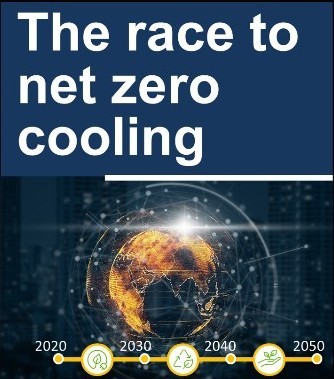The race to net zero cooling

In today’s society cooling is essential for foods, pharmaceuticals and for human comfort. Cooling systems are often energy intensive and polluting through the energy used to power them and the refrigerants used which often have high global warming potential (GWP). In 2019 the UK became the first major economy in the world to introduce legislation that provides a binding target to reach net zero emissions by 2050. Many large companies have already pledged to reduce their carbon emissions by at least half by 2030. Some, such as Danfoss and Carrier have pledged to have carbon neutrality across their operations by 2030.
Reducing emissions from cooling is part of this process. However, as temperatures rise due to global warming there will be a greater need for cooling. In addition cooling is becoming more accessible in low income countries and so although there are significant benefits from cooling in terms of health and welfare, the emissions from cooling are likely to increase without interventions.
Many initiatives are in place to reduce existing emissions and limit the increase in emissions due to the projected increase in equipment being placed on the market. The application of minimum energy performance standards (MEPS) is considered one method to encourage the use of super-efficient equipment. MEPS for cooling appliances and equipment are already in place in over 73 countries. Although energy labels and MEPS for many refrigerated items such as domestic, professional and commercial refrigerators are applied in Europe, there are still many countries that do not regulate energy usage. The United 4 Efficiency Model Regulation Guidelines (which involve RD&T as part of the expert group) is an initiative to help governments in emerging economies to develop regulatory or legislative framework for MEPS and energy labels (https://united4efficiency.org/resources/model-regulation-guidelines/). Recent work has developed guidance for domestic refrigerators, air conditioners and commercial refrigerators and work is just beginning to develop guidelines for off/semi-off grid refrigerators.
As electricity grids decarbonise, the emissions from energy generation will reduce and the proportion of emissions related to the refrigerants will increase. The European F-gas regulations have had a major impact on markets by gradually reducing the allowed GWP of refrigerants in refrigeration equipment. Since January 2022 the F-gas regulations have banned the placing on the market of new hermetically-sealed commercial refrigerators and freezers if they use a refrigerant with a GWP of 150 or more. The same ban applies to multipack centralised commercial refrigeration systems with a rated capacity of 40 kW or more. The regulations are currently being updated in Europe and the UK and may introduce even more ambitious targets. Until recently most available synthetic refrigerants with a GWP of <150 were mildly flammable. However, this has recently changed with the introduction of R471A (GWP of 148) which is an A1 refrigerant (not toxic and non-flammable). Other natural refrigerant options are available, for example CO2 have been widely applied in supermarkets as reported in our last newsletter (https://www.rdandt.co.uk/news/CO2_testing).
One of the major challenges is to ensure that emerging economies move to efficient and environmentally sustainable options at the point new equipment is installed. This requires not only education and training but adapting equipment for new markets where use, environment and support is very different from more established markets. There is increasing focus on assisting these markets and this is an area that RD&T are increasingly working in with international development and aid organisations.
If you would like further information on net zero initiatives, please contact Judith Evans at RD&T (j.a.evans@rdandt.co.uk).